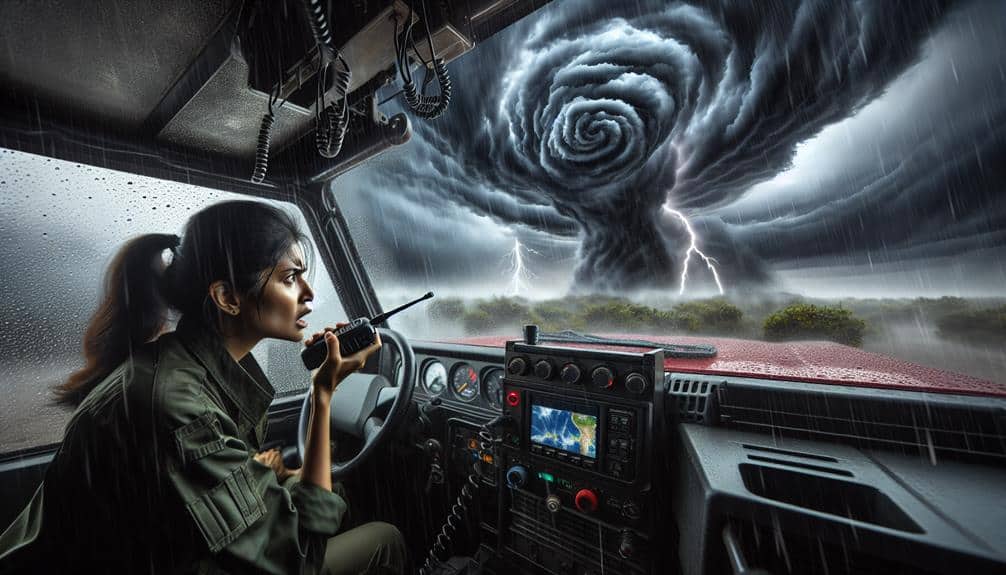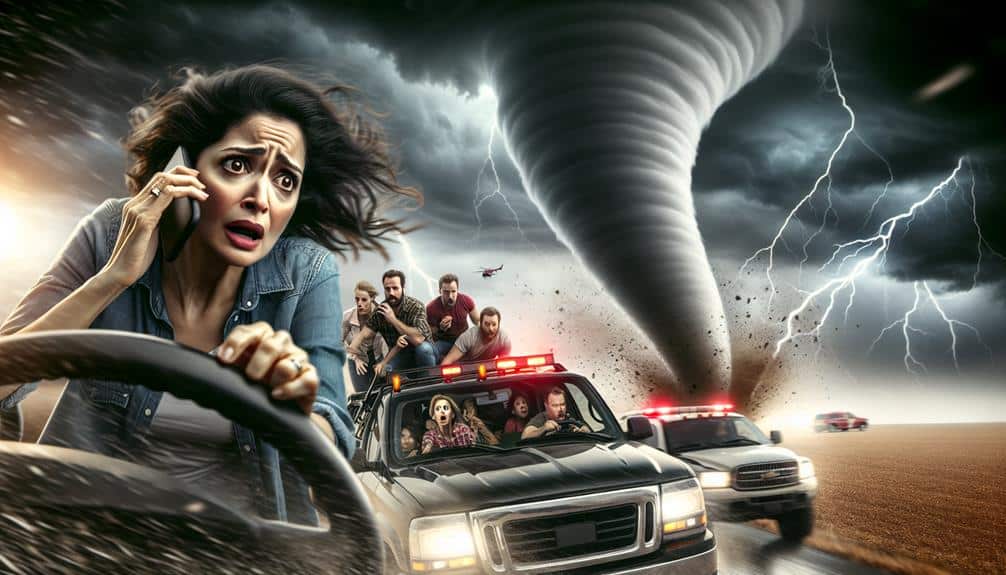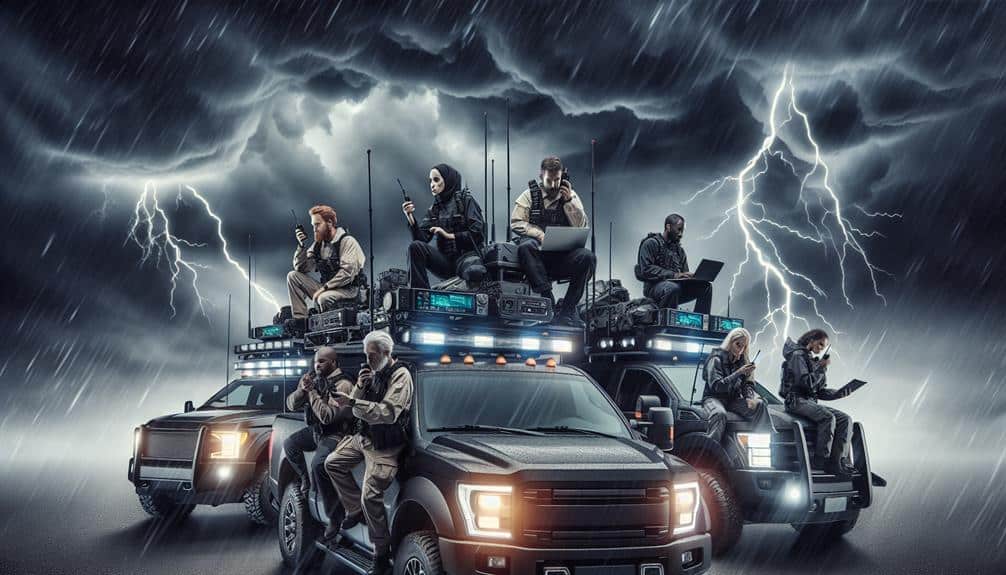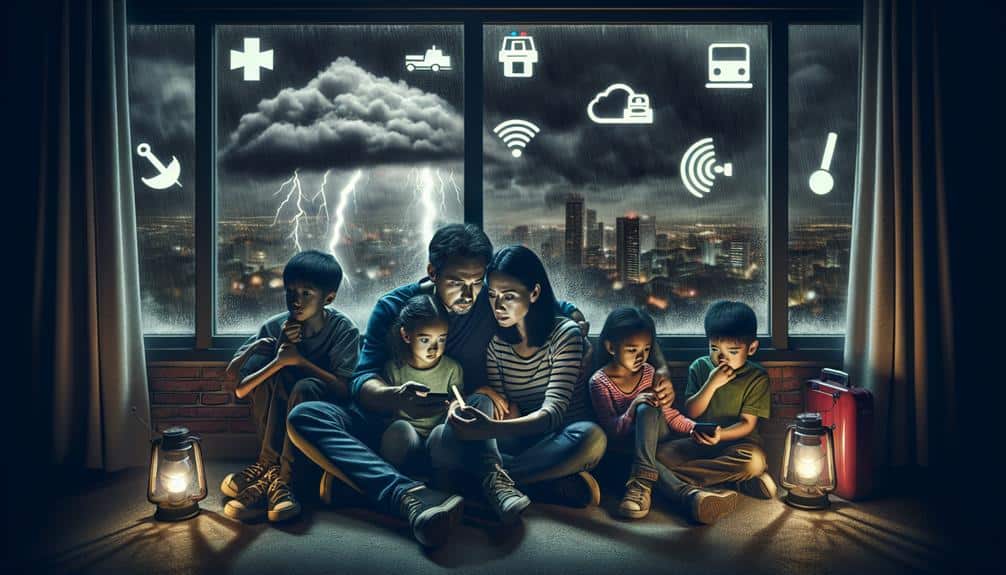As storm chasers, we must emphasize safety and clear communication with 911. Always use GPS tools for precise location updates and double-check coordinates before calling. Give exact locations using coordinates or landmarks, and continuously update information. Stay calm, deliver accurate, specific weather descriptions, and use proper meteorological terms. Listen carefully to dispatchers, follow their instructions, and provide real-time updates on changing conditions. Effective communication and composure are key to ensuring prompt and effective emergency responses. Explore further to grasp the full spectrum of critical communication strategies for storm chasers.
Key Points
- Verify and provide exact GPS coordinates or intersections when reporting.
- Maintain calm and clear communication to convey accurate information.
- Regularly update the dispatcher with real-time situational changes.
- Use precise meteorological and location terminology for clarity.
Prioritize Safety First
Before we even think about chasing a storm, we must always prioritize our safety above all else. To make sure we're prepared, we first need to focus on equipment readiness. Our gear should include a dependable weather radio, GPS, first aid kit, and durable, weather-appropriate clothing. Each item must be checked and double-checked to verify it's in working order.
Equipping ourselves with the right tools is just the beginning. We also need a strong emergency response plan. This plan outlines what steps to take if we encounter severe weather conditions or unexpected emergencies. Establishing clear communication channels with our team is essential. Everyone should know emergency contact numbers, and we must brief each member on their specific roles during a crisis.
Furthermore, we should maintain an up-to-date list of local emergency services and have multiple means of communication, such as cell phones and two-way radios. Practicing emergency drills can help us stay sharp and ready to act swiftly.
Accurate Location Reporting
Accurate location reporting is vital for ensuring timely and effective emergency responses. When in the field, our ability to provide precise details about our location can make a significant difference. It starts with using tools that enhance location precision. GPS devices and storm tracking apps are invaluable. We should always verify our coordinates before reaching out to 911.
Communication accuracy is key. When reporting our location, we must be clear and specific. Instead of saying, 'We're near the old barn,' we should provide exact coordinates or a well-known intersection. This minimizes confusion and speeds up the emergency response.
As storm chasers, we're well aware of how rapidly conditions can change. Regularly updating our location when on the move is essential. This guarantees that emergency services have the latest information, allowing them to reach us swiftly if needed.
We can also utilize landmarks as supplementary information but should always prioritize exact coordinates.
Clear and Concise Information
When contacting 911, we must provide precise location details and describe any immediate threats clearly and concisely. This guarantees emergency responders can act swiftly and effectively.
Let's focus on delivering accurate information to maximize their response efficiency.
Exact Location Details
Providing our exact location with clear and concise information is important for effective communication with 911 dispatchers during a storm chase. When we're out monitoring weather conditions and storm patterns, knowing our precise coordinates can save lives. It's vital that we relay our location accurately to guarantee a swift emergency response.
Using tools like GPS or mobile apps that provide real-time coordinates can greatly improve the efficiency of our communication protocols.
We need to be clear and detailed when describing our location. Instead of vague descriptions like 'near the old barn,' we should provide specific latitude and longitude, or reference well-known landmarks and road intersections. This level of detail helps dispatchers deploy emergency services promptly and accurately, minimizing delays.
Moreover, understanding the layout of our surroundings and keeping maps handy can aid in providing precise information. During a storm chase, conditions can change rapidly, and our ability to communicate our exact location without hesitation is crucial.
Immediate Threats Description
During a storm chase, we must swiftly and clearly describe any immediate threats to guarantee a rapid response from emergency services. This secures not only our safety but also the safety of those in the affected area.
Here's how we can make our communication more effective:
- Describe Specific Weather Conditions: Clearly state what we're witnessing, such as tornadoes, flooding, or hail. Use precise terms like 'rotating funnel cloud' or 'flash flooding.' This helps emergency contacts understand the severity of the situation.
- Identify Evacuation Routes: Inform dispatchers about blocked roads, downed power lines, or any other obstructions. Mentioning clear evacuation routes can help emergency responders reach the scene faster and guide others to safety.
- Check Signal Strength: Secure our signal strength is strong before calling 911. Weak signals can result in dropped calls or garbled communication. If possible, use a landline or a satellite phone, especially in areas with poor cellular coverage.
Use Proper Terminology
We must use proper terminology to guarantee our reports are accurate and actionable.
Clear weather descriptions, precise location reporting, and specific incident details help emergency responders understand the situation quickly.
Clear Weather Descriptions
Why is it important to use accurate meteorological terms when describing weather conditions to 911 dispatchers?
Clear, accurate communication is vital for ensuring effective responses, especially when storm behavior can change rapidly. Using proper terminology helps us convey the severity and specifics of the situation, enabling dispatchers to coordinate timely safety precautions and resources.
When describing weather patterns, we need to adopt robust communication strategies that guarantee our messages are understood without ambiguity. Here's how:
- Use Standardized Terms: Descriptions like 'supercell,' 'funnel cloud,' and 'wall cloud' are universally recognized. This eliminates confusion and guarantees everyone, from dispatchers to emergency responders, is on the same page.
- Be Specific: Instead of saying 'it's windy,' specify the wind speed and direction. For example, 'gusts up to 60 mph from the southwest.' Detailed information helps emergency services assess the conditions accurately.
- Describe Visual Cues: Mention specific visual indicators such as 'rotation in the cloud base' or 'hailstones approximately 2 inches in diameter.' These details provide important insights into the storm's intensity and potential impact.
Precise Location Reporting
Accurate meteorological terms keep our weather descriptions clear, but precise location reporting guarantees emergency services can act swiftly and efficiently.
When we're out in the field, pinpointing our exact location is of utmost importance. Using tracking devices like GPS guarantees that we can relay our position accurately to 911 operators.
Instead of vague references, we should provide exact coordinates or specific landmarks. This precise information can shave essential minutes off response times.
It's also vital to familiarize ourselves with local geography and road names before heading out. By integrating this knowledge with real-time data from our tracking devices, we can give responders the best possible information.
Clear communication about our location, combined with detailed reports on weather conditions, ensures that emergency personnel know precisely where to go and what they're facing.
Specific Incident Details
How can we ensure our incident reports are both accurate and useful for emergency responders?
To guarantee our incident documentation is effective, we must focus on clear and accurate communication strategies. By doing so, we help emergency response teams act swiftly and appropriately.
1. Use Proper Terminology:
When describing weather phenomena, we need to use precise terms like 'tornado,' 'hail,' or 'flooding.' This helps emergency responders understand the severity and nature of the incident without ambiguity.
2. Detail Specific Observations:
It's essential to report specific observations such as the size of hailstones, the speed and direction of a tornado, or the extent of flooding. Precise details in storm tracking can make a significant difference in the emergency response.
3. Time and Location Stamps:
Always include the exact time and accurate location of the incident. This allows responders to track the storm's progression and anticipate future impacts, aiding in better resource allocation.
Stay Calm Under Pressure

Staying composed during a storm chase is crucial for effective communication with 911 dispatchers. When we manage stress and maintain focus, our ability to convey critical information improves dramatically. Stress management starts long before the chase; it involves mental preparation and building resilience. By training our minds to stay calm and focused, we can handle high-pressure situations more effectively.
We can practice scenarios where we simulate making emergency calls during intense moments. This mental preparation helps us to anticipate our reactions and better control our responses. Resilience is key here. We need to remind ourselves that staying calm isn't just about our safety, but also about ensuring dispatchers receive the clear, concise information they need to assist us.
During an actual emergency, taking deep breaths and grounding ourselves in the present moment can help mitigate panic. We should focus on the task at hand, which is communicating clearly and efficiently. Keeping our tone steady and our descriptions precise allows 911 dispatchers to understand the severity of the situation and provide appropriate assistance.
In this way, staying calm under pressure isn't just a skill; it's a crucial component of successful storm chasing.
Follow Dispatcher Instructions
Once we've maintained our composure, it's vital to listen carefully and follow the instructions provided by the 911 dispatcher. Effective dispatcher communication is pivotal for a swift emergency response. As storm chasers, our ability to respond accurately can make a significant difference in the outcome of the situation.
First and foremost, we need to actively listen to the dispatcher. They're trained to guide us through the emergency and provide specific instructions tailored to the current scenario. Misunderstanding or disregarding these instructions can lead to delays or even jeopardize our safety.
To make sure we're following the dispatcher's instructions effectively, we should:
- Stay Focused: Avoid distractions and concentrate on the dispatcher's words. Their guidance is our lifeline in an emergency situation.
- Ask for Clarification: If any instruction isn't clear, don't hesitate to ask the dispatcher to repeat or explain further. Clear communication is key.
- Follow Step-by-Step: Execute the instructions methodically as given. Rushing or skipping steps can lead to errors or compromised safety.
Update When Situation Changes

We must promptly update the dispatcher if the situation changes to guarantee the most accurate and effective emergency response. In the ever-shifting landscape of storm chasing, conditions can change in an instant. Real-time updates are essential.
When we observe changing conditions, such as an unexpected shift in the storm's path or sudden intensification, it's our duty to relay this information immediately.
Timely notifications secure that emergency services can adapt to the evolving situation. For example, if a tornado suddenly touches down, our prompt update can redirect resources to the new hotspot, potentially saving lives.
By keeping the dispatcher informed, we contribute to a more coordinated and effective emergency response.
Let's remember, our role in storm chasing isn't just about the thrill; it's about responsibility. Providing real-time updates and maintaining clear communication with 911 can make a significant difference.
Even small changes, like a shift in wind direction or a drop in barometric pressure, should be reported. These details help dispatchers make informed decisions.
As storm chasers, we embrace the freedom to explore nature's fiercest phenomena, but with that freedom comes the responsibility to guarantee public safety through precise and timely updates.
Frequently Asked Questions
What Should I Do if My Phone Signal Is Weak During a Storm?
If our phone signal's weak during a storm, we should use emergency signals and have backup plans. Effective communication strategies and staying updated with weather alerts guarantee we're prepared and can make informed decisions despite connectivity issues.
How Can I Keep My Equipment Protected While Storm Chasing?
To keep our equipment protected while storm chasing, we prioritize equipment maintenance, employ weatherproofing methods, use durable cases, and secure everything firmly. Regular checks and proper storage guarantee our gear withstands the harsh conditions we encounter.
Are There Any Apps Recommended for Storm Chasers to Use?
We recommend apps like RadarScope and Storm Shield for storm chasers. They provide real-time weather updates and allow us to set emergency contacts. Staying informed and connected guarantees we're prepared for any situation while chasing.
What's the Best Way to Document Storm Activity for Future Reference?
When the sky's a canvas of chaos, we capture it with high-resolution photos and videos. We use cloud-based data storage for safekeeping and meticulous photo organization to guarantee easy access. Let's treasure our storm adventures forever.
How Do I Handle Encounters With Wildlife or Dangerous Debris During a Storm?
When we face wildlife encounters or debris hazards during a storm, we take safety precautions and follow emergency protocols. We maintain distance, avoid sudden movements, and seek shelter immediately to guarantee our safety and freedom to continue storm chasing.


